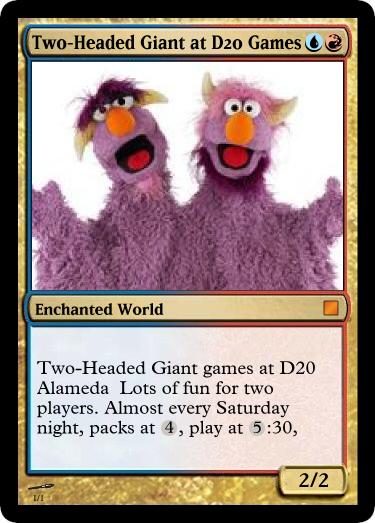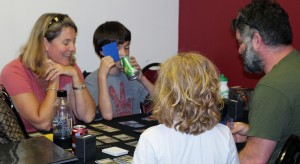 Two headed Giants are one of our most popular Magic Events at D20. It”s a ton of fun and best way EVER for bringing in people who haven’t felt comfortable playing before. It works great for significant others, buddies who want to check it out, or just friends who want to play.
Two headed Giants are one of our most popular Magic Events at D20. It”s a ton of fun and best way EVER for bringing in people who haven’t felt comfortable playing before. It works great for significant others, buddies who want to check it out, or just friends who want to play.
(It is particularly great for Moms or Dads who want to have a really cool date night with their kids. This event is a GREAT way for parents to figure out what this thing the kids are doing is anyway, and for the kids to get a chance to be the ones who know what is going on for a change. ;-)Because you play as a team and can help each other out, the kid gets to be the smart one for a change, and the parent gets to play without needing to worry about “doing it wrong”. Also…very fun to play together against another team.)
How does it work? Each giant consists of two players who work together as a team. They share a single (30 point life total) and draw their cards at the same time, play at the same time, attack and defend together and in general help each other out. They each open a fixed number of packs to use to make their decks (usually 4), and can then mix what was in those packs in to one big pool to use for making one 40 card deck for each player. Each round is on single (usually longer then normal) game, and we play 3 rounds total, with a prize going to each head on the winning team. It is not only ok for the two heads to show each other their cards and talk among each other, its at least half of the fun.
You can’t do anything to your partner head, you couldn’t do to an opponent.
- Each Deck is 40 card minimum. Keep as close to that as you can (~23 cards, and 17 land). Since it is a sealed, you can have more then 4 of a particular card besides basic land if you have them in your pool.
- There IS such a thing as a free Mulligan in Two headed Giant–each player can have one free mulligan(can put their opening hand back, reshuffle and get 7 new cards) at the beginning of the game. The team that wins the roll has the option of going first and not drawing a card, or going second and drawing a card.
- Each team starts with 30 life. The game ends when one team goes to 0 life, or time runs out (draw) or either of the players on the team is forced to draw a card when they have no cards left in their library (usually at the beginning of their turn.)
- Attacks go to the “body” of the other team….they can use any of their creatures to block if they want to.
- All attacks from a giant happen at the same time (both players attack at the same time). Declare ALL attacks before the other team needs to respond
- Effects, like Battalion, that trigger when multiple creatures attack together, count all the creatures attacking a the same time unless those effects specifically say “creatures You control..see the You rule later.)
- You can’t do anything to your partner, you couldn’t do to an opponent.
- You don’t share lands, can’t put equipment on their creatures
- The You Rule…any affect that includes the word “you” in it, for example “creatures you control” refers to the head(player) who cast it, not the giant. If “you” would gain life, it goes to the pool of life the team controls. If “creatures you control get +1,+1” those are only the creatures that player has under their control.
- The Target Player rule: Spells and effects that do anything but damage to “target player” only affect one of the heads and the person casting the spells gets to decide which.
- The Opponents Rule: Spells that talk about “each opponent” or “all opponents” will effect BOTH heads of the giant. Which makes some cards EXTREMELY effective in Two headed Giant….such as Extort, where you gain a life and each opponent loses a life when you extort…
In general, the cards will do a pretty good job of telling you how things should work in two headed giant as long as you pay attention to the “you, each opponent, all opponents” etc. Remember, Hexproof prevents spells from things being targeted by spells your opponents control…and your partner is (very hopefully) not your opponent.
Advice:
- Talk to each other and work together. A two-headed giant that bickers and each head just does what they want to do ends up with their final argument being about who was responsible for them lying on the ground, looking up at another giant giving each other the giant high five.
- You can make decks that are not balanced because you have two decks to work with. It’s ok to have one deck that concentrates on the attacking, while the other concentrates on keeping things safe and getting rid of their opponents stuff.
- Games last longer, so you can put in some bigger cards that might not usually get a chance to be played.
- Mark the most valuable cards in each of the 4 packs that each player opened, so you can get those back to each other at the end of the time…getting all the cards re-split up never works…usually you just both end up with the decks you built and then giving each other back the specific cards you ID’d as being ones you wanted back.
What is it?: Two-Headed Giant Magic Tournament. (Two players on the same team, sharing life and playing in parallel against other teams of players) Each team gets 30 life points between the two of them. It is an extremely fun way for experienced players to play with players who are just getting good with the game.
Do I need to know what I’m doing?: Since both players play at the same time and can show each other their cards, as long as one of the two players knows what they are doing, nothing is required of the other player. It is the best, most fun way to learn the game.
Why is is called Two headed Giant? Both players share the same (larger) life total of 30 rather then the normal 20 points. Each “head” (player) takes their turns at the same time and can consult with each other, but they play in parallel, not able to share resources such as land or equipment (if you don’t know what those things are, don’t worry about it, your partner will.

Who tends to play? Teams usually comprise of buddies, parent/kid combos, and a lot of couples. Both players play together, sharing a life total, showing each other their cards, consulting with each other and playing at the same times. Because of that it is both great social fun, and probably the best way for a new player, or someone who is just curious what their buddy/kid/or SO likes so much about the game to get a chance to try without feeling any pressure to know all (or any) of the rules. Think of it like tandem skydiving…you get all the fun, without having to worry about when to pull the rip-cord.(It is particularly great for Moms or Dads who want to have a really cool date night with their kids. This event is a GREAT way for parents to figure out what this thing the kids are doing is anyway, and for the kids to get a chance to be the ones who know what is going on for a change. ;-)Because you play as a team and can help each other out, the kid gets to be the smart one for a change, and the parent gets to play without needing to worry about “doing it wrong”. Also…kids love having their mom or dad help them try and beat another team.)
Do we need to make and bring our own decks? Nope. This is what is called a sealed deck tournament, which basically means that each team gets a fixed number of packs (7) of Magic cards to build the two decks used to play in the tournament.
How do you make the Decks? A standard two-headed Giant has each player getting 4 packs of the current set. The players then figure out which cards are important to them to get back at the end of the night and combine all the cards together to use as the pool for making two 40 card (minimum) decks, one for each player . You’ll have plenty of cards to use to make interesting decks with that number of packs, and the cards you open are yours to keep.
Why only one game per match? Two headed Giant takes longer to play, so there is not enough time to do the standard 2-out of 3 games.
When is is and how long does it go? Get packs as early as 4 pm, starts at 5:30 and the last match usually ends by 8:30 (if not earlier).
Other Rules
- Each team sits together on one side of the table. Each team decides the order in which its players sit. The player seated on the right within each team is the primary player, and the player seated on the left is the secondary player.
- The Two-Headed Giant variant has two unique features:
- Each team has a shared life total, which starts at 30 life.
- Each team takes turns rather than each player.
- With the exception of life total, a team’s resources (cards in hand, mana, and so on) are not shared in the Two-Headed Giant variant. Teammates may review each other’s hands and discuss strategies at any time.
- Teammates can’t manipulate each other’s cards or permanents.
- A player who is dissatisfied with his or her initial hand may mulligan. First, the starting team takes any mulligans. For a team to take a mulligan, each player on that team decides whether to shuffle his or her hand back into the deck and then draw a new hand of seven cards. All players on that team who chose to do so take their mulligans at the same time. After each player on that team who took a mulligan looks at his or her new hand, the team repeats the process, resulting in a hand of one fewer card each time, until the hand size reaches zero cards. Teammates may consult during this process, but a player can’t see the result of his or her teammate’s mulligan before deciding whether to take a mulligan at the same time. Once a player has decided to keep a hand, those cards become his or her opening hand. That player can’t take any more mulligans, but his or her teammate may. Once each player on the starting team decides to keep an opening hand, the other team may take mulligans..
- Teams have priority, not individual players.
